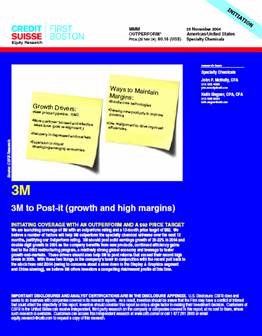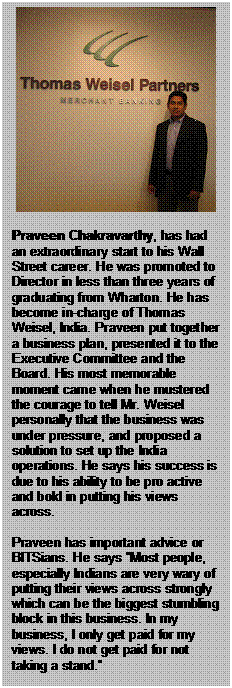BITSians on Wall Street
By Anupendra Sharma (’87 Eco Instru), Sandeep Mukherjee (’95 Phy Mech)
Equity & Fixed Income Research
Mary Meeker. Henry Blodget. These are just two equity analysts (one famous, one infamous) on Wall Street who have at one time or the other been household names in the United States. Another who briefly became famous was Ashok Kumar, a fixed income analysts at Lehman, who correctly predicted the 2000 collapse with a sell on Amazon.
The work of Research analysts is critical because it guides the direction of flow of money on Wall Street. Experts in the field supply analysis, information, advice to clients, and predict future trends. Some analysts on Wall Street are followed very closely and hugely respected for predicting markets and stocks correctly for years.
 Equity Research analysts are sector experts, and spend their entire lives covering up to 20 companies in one or two related sectors at any point in time. The workload is cyclical, and revolves around the quarterly earnings announcements that are so closely watched. Analysts often appear on CNBC and MSNBC, giving their impressions about a stock. Well respected analysts have a lot of clout in the marketplace, and make the stock move up or down depending on their ratings. Equity Research analysts are sector experts, and spend their entire lives covering up to 20 companies in one or two related sectors at any point in time. The workload is cyclical, and revolves around the quarterly earnings announcements that are so closely watched. Analysts often appear on CNBC and MSNBC, giving their impressions about a stock. Well respected analysts have a lot of clout in the marketplace, and make the stock move up or down depending on their ratings.
Fixed Income Research analysts are the less glamorous peers. These analysts research the publicly traded debt of companies, which is an enormous market in itself. Fixed Income Analysts analyze company fundamentals. The work becomes more exciting in distressed situations (when companies approach bankruptcy – a common phenomenon in recent times) and hedge funds place bets on where these companies will end up. Small bits of news can cause large fluctuations in price. The issuance of debt, changes in capital structure or newsworthy events trigger reports from the analysts. Up to four All-Star analysts in every sector are named by IDD and the Wall Street Journal every year.
What analysts do?
Analysts have high stress jobs. Bold calls on companies, good or bad, can create instant recognition, and trigger the flow of billions of dollars. Henry Blodget made a $400 price target call on Amazon which came true and made him the most famous equity analyst of all time. In July 2005, Matt Simmons appears to have made a wrong call that oil would hit $100 per barrel, but it put him on every newspaper, TV station and channel in the world. Can you handle that kind of pressure?

Analysts create financial models to value the companies they cover, and try to calculate the quarterly earnings per share, which drives the share price. Since investors, many of whom are large financial institutions, depend on these reports, there is a great deal of stress not to get this figure too far wrong.
Investment banks hold investor conferences all year round, where CEOs and CFOs come together with investment managers and other analysts to talk up their companies, and provide a short and long term outlook for their business.
Analysts spend a lot of time talking to the market as they move further up in their career. They talk to industry experts, CEOs and CFOs of the companies they cover, and competitors as well to understand how the dynamics of the industry are shaping up. The ability to connect with with powerful and influential people, build a meaningful relationship and provide intelligent insights is a very useful skill.
There is a lot of writing involved. Short reports are produced once a quarter on each company, and significantly longer ones at least once a year. When coverage is first initiated on the company, the report can contain very interesting details on the strategy, markets and products of the company, running up to 100 pages. One analyst said he spends the whole day talking to people. Come 6 PM, he unplugs his computer and starts writing late into the evening.
Why join research?
Research allows one to develop excellent domain expertise about a group of companies in great detail (end markets, consumers, suppliers, competition, profitability, risks, managements, track records) and then performs financial analysis to determine the price targets. This information is usually communicated through written research reports, TV interviews as well as one-one discussions with portfolio managers looking for investment ideas.
Research is a good area for BITSians especially those who have specific domain expertise, and/or are looking for a switch. Research is a way to build strong domain expertise. The industry offers flexibility to move over to the Money Management or Hedge Fund side of the business, like Arun Kumar. There are many Indians, especially in the high-tech sectors such as Software, Hardware and Semiconductors.
BITSians and Research
There are four BITSians in Equity Research in the US, but none in Fixed Income Research. Wamsi Mohan (’90, Kellogg MBA 2003) works at Merrill Lynch covering Enterprise Hardware companies. Rajesh Raju (’89, MBA Chicago 2001) covers Infrastructure Software companies at Robert Baird. Sumit Dhanda (’87) works in Semiconductors Research at Bank of America. Praveen Chakravarthy (’90, Wharton MBA 2002) relocated from San Francisco to Mumbai in October 2005 as Director and Head of Thomas Weisel India, to start up the operations there.
Wamsi joined Equity Research because he was tired of engineering. He was excited by the financial markets. But getting an equity research job right out of school wasn’t easy. Instead, he went to a corporate finance group, but later moved when the opportunity came.
Rajesh Raju started out in investment banking, then moved to Equity Research. Praveen had a defining moment when he was sitting in the Corporate Finance class by Prof. Franklin Allen. He says “I truly understood the meaning and power of the “Invisible Hand” as postulated by the great Adam Smith.”
Love research?
The BITSians we spoke to love their jobs. Praveen says “My job involves analytics, strategy, operations and vision. I cannot think of a more complete job.”
Rajesh Raju reiterates “Great thing about following the markets is that there is something new everyday. I tend to compare “Markets” to “Golf”, you can get better at it, can never master it. So you are constantly learning and getting humbled along the way.”
Wamsi is racing up the learning curve. He says “I really enjoy the aspect that each day brings something new. No one knows what news might occur on a given day which might impact the stock prices. To quickly absorb the news and translate that to financial impact is key to the job. Macro changes include tendency to ramp up outsourcing in areas of pure number crunching. “
Winds of change
In December 2002, the economics of the Research industry changed forever, as regulation rebuilt the Chinese Wall. Eliot Spitzer went after the banks and broke the cozy relationship between investment banks and research. The top banks paid $1.4 billion in fines.
The problem was essentially one of conflict of interest. Research is supposed to be independent. But in the pre-Spitzer days, investment bankers executed the IPOs, and the research analysts talked up the stock to the investors. The banks with the most influential analysts were chosen by companies to run their IPOs. Everyone on the Street got rich. The highest paid analysts were the ones who could talk up a stock to investors. Everyone was selling stock and being compensated for it. Jack Grubman got paid $20 million a year to provide investors with “independent advice”.
But when the telecom and tech bubble burst, shareholders were left holding worthless stock. That’s when the backlash started and Eliot Spitzer sprung into action.
Eliot Spitzer’s settlement has recreated the Chinese Wall. VP Rajesh (Investment Banking) and Praveen Chakravarthy (Equity Research) are at the same firm but cannot talk business with each other.
Since Research is back to writing and selling what it writes (that retails at approx. $8 per page), this has resulted in an industry shakeout. There is a close relationship with Sales & Trading. Funds reward good research with trading of stock and bonds through the firms; this subsidizes the research.
As the bulge bracket firms pared their ranks to focus on covering only large companies, smaller independent firms have sprung up to cover the mid-tier and small-cap sectors. While these were intended to give customers more choice, they have largely struggled. India is beginning to take advantage of the significant opportunities in offshoring by setting up research back office operations, or even independent shops to reduce the costs of research. WS Ravishankar (’87) and Sandeep Talwar (’87) run one such firm in India.
Wamsi echoes the changes on the Street. “Sell-side analyst slots on the street have been shrinking since the bubble days; because of the new regulatory environment the economics are not as attractive for investment banks, most are running lean research shops.”
Praveen has a more aggressive take. He says “I postulate that this model will break very soon and different models will emerge. So, people looking for a job as a Equity Research Analyst will have to be aware of what they get into and be prepared to change dynamically with new business models that will emerge.
Because of these changes, BITSians should think long and hard about the changes on Wall Street. Broadly, declining trading commissions, separation of investment banking and research and the “push” model of current Wall Street research is under severe pressure.
Stephen Castellano, a former researcher predicts that hedge funds are going to acquire many of these independent research firms. This year a quarter of Wall Street income will come from servicing Hedge Funds. The sheer size and competitiveness of hedge funds makes it difficult to beat the market, hedge funds may have to acquire more resources, including some of these research firms.
What after Research?
Equity Research can be a good long term career. For those seeking a move after a few years, good analysts can move into the more lucrative buyside into asset management research or hedge fund analyst positions. Here, they may eventually evolve into managing funds. Analysts with strong C-level networks within industries have also joined investment banking.
How to get into Equity Research
 The MBA is instrumental in switching careers, into the Research industry. A CFA is also very relevant for the Research qualification if one does not have an MBA. The MBA is instrumental in switching careers, into the Research industry. A CFA is also very relevant for the Research qualification if one does not have an MBA.
For those looking to get into research, start running a small stock portfolio, have three stocks or bonds at any time that are your buy or sell recommendations and keep a close watch on the macro and micro forces impacting at least two sectors. Only if you live and breathe the markets, read a lot and demonstrate passion, can you enter this industry. |

